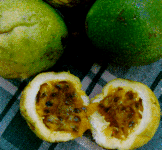Australia is the largest single market for passion fruit and the bulk is used for blending with other juices and in softdrinks.

The passion fruit is a native of tropical America and was noted by the Spanish in Brazil in the 1500's. There are more than 400 species of which at least 50 or more are edible.
The two main commercial varieties are Passiflora edulis L. a
purple fruit and P. edulis f. flavicarpa a yellow variety.
Australia is the largest single market for passion fruit and the bulk is used for blending
with other juices and in softdrinks.

The total carbohydrate content is around 15-20 % with slight variations between the
purple and yellow varieties.
The breakdown (in percent) is given as:
fructose glucose sucrose purple 33.5 37.1 29.4 yellow 29.4 38.1 32.4
with a trace of 7 others.
Both yellow and purple have a high acid content (pH around 3) and the breakdown has been given as:
meq/100g citric acid malic acid lactic, malonic, succinic, ascorbic acids purple 13.1 3.86 7.49, 4.95, 2.42, 0.05 yellow 55.0 10.55 0.58, 0.13, trace, 0.06
The sugar/acid ratio is sometimes used as a measure of sweetness and there is a significant difference between the purple and yellow varieties, 5:1 compared to 3:8, so that the purple is generally considered to be sweeter.
In 1963, it was determined that the colour of the passion fruit was not due to
anthocyanins and only trace amounts of flavones were found as well.
In 1972, further work identified the major carotenoid pigments in the purple variety,
which included:
AlkaloidsIn 1975, 7 alkaloids were detected and 4 were identified as harman(e),
harmol, harmin and harmalin. Pharmacological tests showed that the juices had slight
sedative effects. |
By 1972, over 165 compounds had been detected in the volatiles of the juice of the yellow variety. The highest quantities being C2-C8 esters of the C2-C8 fatty acids. Other volatiles included the degradation products of carotenoids, sulfur-containing components and some unusual aliphatic esters.
Casmir and Whitfield in 1978 introduced the concept of the "flavour impact
value" and from the over 300 volatile flavourants that they detected, identified 22
as having passion fruit flavour. Using linear regression methods they were able to
reproduce the natural flavour by combining 15 of these volatile and calculated each
chemicals contribution to the flavour profile.
Flavour-Impact Values
Compound Flavour Concentration Contribution impact value in juice (ppm) to flavour profile (%) 6-(but-2'-enylidene) 79 1.1 30 1,5,5-trimethylcyclohex-1-ene (Z)-hex-3-enyl butanoate 41 0.8 11 hexyl butanoate 6.8 4.1 9 ethyl (Z)-oct-4-enoate 62 0.4 8 beta-ionone 410 0.05 7 edulan I 23 0.8 6 ethyl (Z)-octa-4,7-dienoate 239 0.06 5 linalool 30 0.05 5 ethyl hexanoate 1.3 7.6 3 heptan-2-ol 1.7 5.3 3 (Z)-hex-3-enol 26 0.3 3 S compounds 76 0.1 3 hexanol/ nonan-2-one 1.8 4.0 3 Rose oxide 45 0.2 2 methyl butanoate 0.7 8.3 3
"Tropical Fruit Processing", Edited by J. Jagtiani, H.T. Chan, Jr. and W.S.
Sakai Food Science and Technology, A series of monographs, 1988, Academic Press, Inc.,
1250 Sixth Avenue, San Diego, California, 92101.
"Food Flavourings", Edited by P.R. Ashurst, Blackie Academic & Professional,
an imprint of Chapman & Hall, Wester Cleddens Road, Bishopbriggs, Glascow, G64 2NZ,
UK. 2nd edit. 1995.
Created May 1997. Last modified 21st April-98.
URL http://wwwchem.uwimona.edu.jm:1104/lectures/psnfruit.html